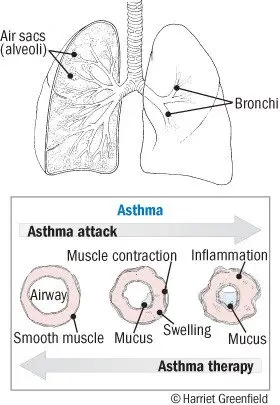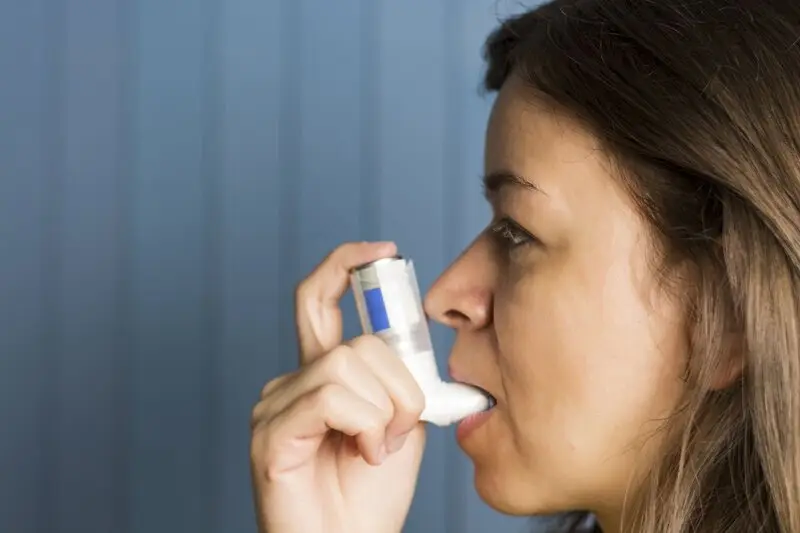What is asthma?
Asthma is a chronic (long-term) lung condition. Air passages narrow and become inflamed. This leads to breathing difficulties and wheezing.
Asthma ranges from mild to severe. Some people have only occasional, mild symptoms. Others have nearly constant symptoms with severe, life-threatening flare-ups.
During an asthma attack, the airways become inflamed. They narrow as the muscles surrounding them constrict. Mucus produced by the inflammation fills the narrowed passageways. As a result, the flow of air is partially or completely blocked.
Asthma affects the lung's larger and smaller airways.
What causes asthma-related inflammation is not clear. But several environmental "triggers" have been identified. 
Many asthma triggers are allergens. Allergens cause the immune system to overreact in some people. Common allergens include:
- Animal dander and saliva
- Pollens
- Molds
- Dust mites
- Cockroaches
- Some medications
- Certain foods
Also high on the list of asthma triggers are:
- Viral infections, such as colds and influenza
- Exercise
- Breathing cold, dry air
- Environmental pollutants, such as:
- Cigarette smoke
- Wood smoke
- Paint fumes
- Chemicals
- Strong odors
- Emotional stress
For some people with severe asthma, no specific triggers can be identified.
Asthma can develop early, often before age 5. But its symptoms can begin at any age. The condition has a genetic (inherited) component. It often affects people with a family history of allergies.
Symptoms of asthma
Symptoms of asthma include:
- Wheezing (a whistling sound as air is forcibly expelled)
- Difficulty breathing
- Chest tightness
- A persistent cough
For some people with asthma, a chronic cough is the main symptom.
Symptoms of a severe asthma attack can include:
- Extreme shortness of breath
- Chest tightness
- A rapid pulse
- Sweating
- Flared nostrils and pursed lips
- A need to sit upright
- A bluish discoloration of the lips and fingernails
Between asthma attacks or flare-ups, people with mild or moderate asthma may not have any symptoms.
In some people, symptoms flare up only during or after exercise.
People with asthma tend to have more severe symptoms when they have an upper respiratory infection such as a cold or the flu.
Diagnosing asthma
Your doctor will ask about:
- Any symptoms you have
- How severe they are
- When and where they occur
- How frequently they occur
- What triggers and relieves them
These details will help your doctor find ways to help prevent your asthma attacks.
Your doctor also will want to know about:
- Your personal history of allergies and respiratory illnesses
- Your family history of asthma, allergies and respiratory illnesses
Your doctor will listen to your back with a stethoscope to detect wheezing.
During an attack, your doctor can assess the severity of your flare-up. He will listen for the amount of airflow in your lungs. He will also observe how you are using your chest muscles to breathe. Blue lips or skin are a sign that you are not getting enough oxygen.
Other tests may be done in the office. These include measuring the speed of the air you can exhale forcibly. This is done with a device called a peak-flow meter.
Another test, called pulse oximetry, measures oxygen levels in your blood. It is done by placing a small plastic clip on the tip of your finger.
During an asthma flare-up, blood tests may be done to check for infection. An arterial blood gas (ABG) test can be done on a blood sample. It provides a more accurate measure of oxygen levels. Your doctor also may want you to have a chest X-ray.
Two tests are commonly used to show how well your lungs are functioning:
- Spirometry — This is a more thorough test. It is used to confirm an asthma diagnosis. It also provides more details about your lung function.
During spirometry, you exhale into a device that analyzes the amount and volume of airflow. One part of the test may be repeated after you are given a bronchodilator. This medication relaxes the muscles surrounding the airways. If airflow improves with a bronchodilator, it indicates that you have asthma.
Sometimes a challenge test is done when spirometry appears normal. For this test, you inhale a medication to see if it causes your airway muscles to tighten up. People with asthma are more sensitive to this medication: their airway muscles are more likely to tighten up.
- Peak-flow meter — This is a small portable tube. It provides a quick and easy measurement of air flow from the lungs. It measures the speed of air expelled when you blow forcibly through it.
Peak-flow meters often are given to asthma patients for use at home. They can use them to monitor their asthma. These devices help to detect the earliest signs of an asthma flare-up.
Your doctor may want to do a blood test or allergy skin testing. These tests are used to determine specific substances ("allergens") that can trigger an allergy.
Expected duration of asthma
Asthma in adults often is a lifelong condition. With treatment, symptoms can be controlled. They can be infrequent or very mild.
In about half of asthmatic children, the asthma goes away on its own. Or it becomes less severe over time. However, it may reappear later in life.
Asthma episodes can go away on their own or with the help of asthma medications. Attacks vary in frequency and severity. It is often dependent on what triggers the attack.
Preventing asthma
Some asthma episodes can be prevented by avoiding or minimizing exposure to triggers.
These include environmental triggers such as:
- Cigarette smoke
- Environmental pollutants (especially when pollution and ozone levels are high)
- Strong chemicals
If exercise triggers your asthma:
- Breathe warm, humidified air before and during exercise
- Use inhalers before exercise
Eliminating allergens at home often can go a long way to control asthma symptoms.
If dust mites are a trigger:
- Encase mattresses in airtight enclosures
- Clean your home frequently
- Wash bedding frequently in very hot water
- Remove carpets and heavy draperies from sleeping areas
Some people may need to avoid animals entirely. Others may benefit from taking preventive medicine before an anticipated exposure to animals. Pet owners should keep pets out of bedrooms and bathe them regularly.
Those who are affected by pollens should:
- Stay indoors whenever possible
- Use air conditioning
- Keep windows closed during high pollen season
Prevention also means learning to anticipate future attacks. Monitor your symptoms and peak-flow readings to help identify a coming attack before symptoms develop. This allows you to adjust your medications to prevent an attack.
Early signs or symptoms of an asthma flare-up include:
- Coughing more often
- Increased mucus or phlegm
- Becoming short of breath quickly with exertion or exercise
- Developing a sinus headache or fever
- Having symptoms that resemble a cold:
- Runny or congested nose
- Sneezing
- Watery eyes
Treatment options
The following list of medications are in some way related to or used in the treatment of this condition.
- Singulair
- montelukast
- Trelegy Ellipta
- Fasenra
- Kenalog-40
View more treatment options
Treating asthma
Treatment focuses on:
- Preventing or stopping the inflammation
- Relaxing the muscles that line the airways
If you have chronic asthma, work with your doctor to write an asthma-management plan. The plan specifies:
- How to avoid asthma triggers
- When and how regular medications should be taken
- How to handle acute attacks
- How a peak-flow meter should be used
Several types of medication are available to treat asthma. Some treat acute attacks (the "quick relievers"). Others prevent attacks from happening (the "controllers").
It is important to take preventive asthma medications as prescribed. You should take them even when you are not having symptoms.
- Bronchodilators. Bronchodilators relax the muscles around the airways to improve airflow. They are commonly inhaled. One class of bronchodilators is called beta agonists. It includes albuterol, metaproterenol, and pirbuterol. Beta agonists can be prescribed alone as quick relievers, for mild, occasional symptoms. They also are used as "rescue" medications to stop an attack. They can be inhaled in an inhaler or taken with a nebulizer. A nebulizer is a device that mixes medications with a mist for inhalation. Long-acting bronchodilators are used as "controllers" to reduce the number of asthma attacks.

- Anti-inflammatory medications. These are controllers. They are usually taken regularly, regardless of whether a person is having asthma symptoms. They work by reducing inflammation. This decreases mucous production and reduces constriction of airway muscles.
- Anyone with asthma symptoms that occur more than a couple times per week should consider taking an anti-inflammatory medication along with a long-acting bronchodilator. The first choice is usually an inhaled corticosteroid.
- Corticosteroids also can be taken as pills when inhaled corticosteroids are not completely successful. People requiring emergency care or hospitalization often receive corticosteroids intravenously.
- Leukotriene modifiers are taken by mouth. These drugs block chemicals that cause inflammation and airway narrowing in many people with asthma.
- Biological anti-inflammatory medicines. These drugs help control symptoms in people with severe asthma that is unresponsive to other therapies and requires frequent oral corticosteroids.
- Immunotherapy. Some people with asthma also benefit from immunotherapy. In immunotherapy, the person is injected with increasing amounts of allergens. The aim is to desensitize the person's immune system. Immunotherapy appears to be most effective for mild to moderate asthma symptoms caused by sensitivity to indoor allergens.
Severe asthma attacks must be treated in a hospital. There, oxygen can be administered, and drugs may be given intravenously or with a nebulizer. In life-threatening cases, the patient may need a breathing tube placed in the large airway and artificial ventilation.
When to call a professional
Call your doctor whenever you or your child has persistent:
- Wheezing
- Chest tightness
- Difficulty breathing
- Cough
Some children with asthma may not complain specifically of shortness of breath. However, they may flare their nostrils or use their chest and neck muscles when breathing. These are signs that they are having trouble.
If you already have been diagnosed with asthma, call your doctor if your symptoms:
- Are getting worse
- Are not being controlled by your regular medications
For example, call your doctor if you must use your rescue bronchodilator more than two or three times a day. Also call if your peak-flow-meter readings are in the yellow or red zones.
If you have an asthma attack and your symptoms persist despite your usual medications, seek emergency help immediately.
Prognosis
Although asthma cannot be cured, it almost always can be controlled successfully. Most people with asthma lead relatively normal lives.
Additional info
American Academy of Allergy, Asthma & Immunology (AAAAI)
https://www.aaaai.org/
American Lung Association
https://www.lung.org
National Institute of Allergy and Infectious Diseases (NIAID)
https://www.niaid.nih.gov/




